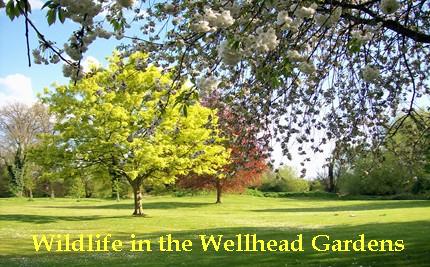|

by KEVIN DAY
There is far more wildlife in the Wellhead Gardens than is at first apparent. Last winter, for instance, was
one of the harshest for many years and the flora and fauna struggled to
survive despite a generous helping hand from the public. The resident
kingfishers in particular had a hard time of it with just a very few holes
in the ice on the river in which to fish but one of the pair did succumb
although not directly to the weather. Sadly, it was taken by a female sparrowhawk in early December.
Another predator in the shape of a grey heron spent much of the winter
skulking around the parkís waterways and was probably responsible for the
loss of goldfish from the ornamental ponds in the War Memorial Gardens and some of the small rudd
along the river stretches. However, there was evidence to suggest that an
otter had also visited the stretch of water near Baldock's Passage at some
point because a carp of 5lb. or more was found half-eaten on the side of
the bank. Otters have been seen further downstream in the Eastgate area
and they are known to travel considerable distances in search of food so
it is perfectly feasible that one has found its way into the park.
The usual winter visitors of redwing and fieldfare were here by late
November and around the same time a couple of more exotic species arrived.
Groups of waxwings were regularly in and out of the park for over three
months and a little egret spent three or four days patrolling the old
cress beds in early January while both snipe and redshank were spotted in
the field ditch next to Baldock's Passage when the weather was at its
coldest.
The underground aquifer ensured that St Peterís Pool stayed relatively ice
free throughout the winter and this became a magnet for black headed and
common gulls as well as the occasional little gull. There were also
unconfirmed reports of a Mediterranean gull on the water in February.
During one particular cold snap a lone lapwing turned up and spent a few
days hoovering up tiny crumbs of bread that had been dropped around the
bench overlooking the pool. In normal circumstances you would be hard
pushed to get within fifty yards of these handsome plovers so to have one
feeding within a few feet of you is most unusual.
Spring finally arrived and fears that the population of small birds may
have been decimated by the cold weather appeared to be unfounded as many
began their courtships and nest building before the snow and ice had
melted. Moorhens and rooks were building in late February closely followed
by mallard, blackbirds and thrushes and many of these had young in the
nest before the first of the migrant birds began to arrive. These, the
swallows, house martins and warblers were quite late this year probably
due to the prolonged north easterly winds that blew well into
April.
Chiffchaffs were singing high up in the trees in mid-April, a practice
that will continue throughout the summer and well into October. Next came
the blackcaps, willow warblers and whitethroats as well as the odd garden
warbler. The first two of these will turn up just about anywhere in the
park area from May through to September although the latter seems to
prefer damper, boggier areas. Though not resident on the Wellhead itself,
the whitethroats can be seen and heard in and around the hedgerow at the
back of the meadow behind St Peterís Pool. There are plans in the pipeline
to improve this meadow with the addition of more wildflower areas over the
next eighteen months but even so it is already an excellent place to watch
swallows and house martins foraging in the air for insects and above them
from May through to August you can usually see the jet black swifts going
about their business.
Of course, the presence of these three species will attract the attention of
the hobbys that feed on them and this year has been no exception as there have
been several sightings of this super fast falcon over the old cress beds
and meadow throughout May and June. Towards the end of the summer, they
will turn their attention to dragonflies which they can catch and eat
whilst still in flight and a good time to see this is usually in the late
afternoon or early evening from July onwards.
Already this spring, there have been plenty of positives for the bird
population in the park and successful breeders include bullfinch,
goldcrest, tree creeper and possibly great spotted woodpecker, as well as
a whole host of other birds both the large and small.
Over sixty five species of birds have been recorded in the Wellhead
Gardens in the last two years and the list grows seemingly month on month
but none of this would be possible without the careful management by staff
at all levels and as the work continues, there are sure to be more
wildlife surprises in the years to come.
|
BIOGRAPHICAL NOTE
Kevin Day, aged 50, founder of Greenhawk,
specialises in environmental management systems which coincides with a
love of wildlife that has been with him since an early age. He was born
and brought up in the town, a pupil of the old Abbey Primary and Bourne
Secondary Modern schools and now lives here with his wife, Amanda, and
their 15-year-old son, William. He is also a member of the Royal Society
for the Protection of Birds and Lincolnshire Wildlife Trust and is always
keen to learn more about our local flora and fauna and so the project with
Bourne United Charities has presented a golden opportunity to study the
Wellhead Gardens which has produced some remarkable results.
|
WRITTEN JUNE 2011

Go to:
Main Index Villages
Index
|
